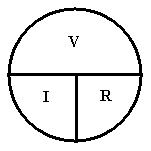A basic law of electrical circuits, the mathematical relationship between electrical voltage, current and resistance: the current in an electric conductor is directly proportional to the voltage across it and inversely proportional to its resistance, i.e., the voltage and current in a conductor exhibit a linear relationship. It states that the current, I, in amperes in a circuit is equal to the voltage, V, in volts divided by the resistance, R, in ohms: thus, I=V/R. Ohm’s law works for DC, and for AC if the resistance is a pure resistance, but if the resistance has any reactive components, inductance or capacitance, the current depends on the frequency as well as the voltage.
